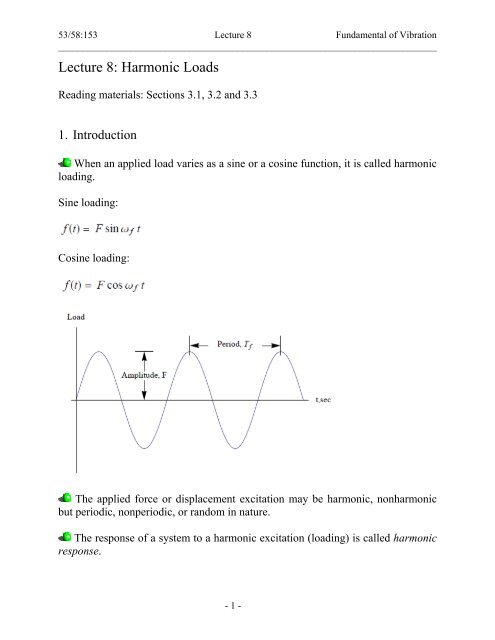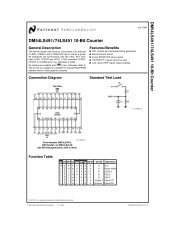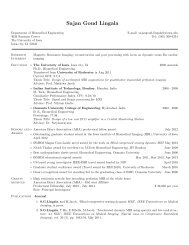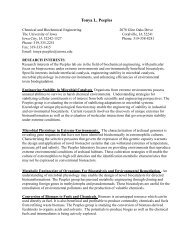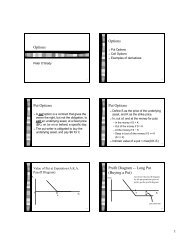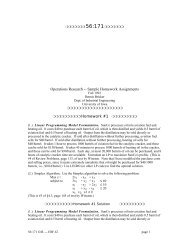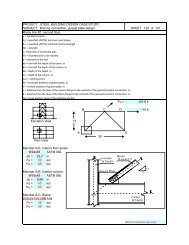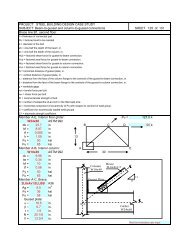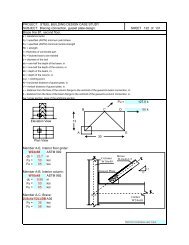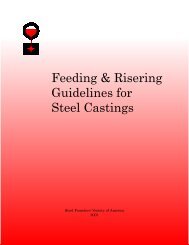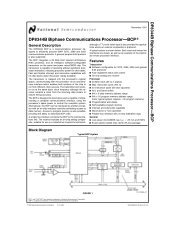Lecture 8: Harmonic Loads
Lecture 8: Harmonic Loads
Lecture 8: Harmonic Loads
You also want an ePaper? Increase the reach of your titles
YUMPU automatically turns print PDFs into web optimized ePapers that Google loves.
53/58:153 <strong>Lecture</strong> 8 Fundamental of Vibration<br />
______________________________________________________________________________<br />
<strong>Lecture</strong> 8: <strong>Harmonic</strong> <strong>Loads</strong><br />
Reading materials: Sections 3.1, 3.2 and 3.3<br />
1. Introduction<br />
When an applied load varies as a sine or a cosine function, it is called harmonic<br />
loading.<br />
Sine loading:<br />
Cosine loading:<br />
The applied force or displacement excitation may be harmonic, nonharmonic<br />
but periodic, nonperiodic, or random in nature.<br />
The response of a system to a harmonic excitation (loading) is called harmonic<br />
response.<br />
- 1 -
53/58:153 <strong>Lecture</strong> 8 Fundamental of Vibration<br />
______________________________________________________________________________<br />
The nonperiodic excitation excitation may have a long or short duration. The<br />
response of a dynamic system to suddenly applied nonperiodic excitations is called<br />
transient response.<br />
If the frequency of excitation coincides with the natural frequency of the<br />
system, the response of the system will be very large. This condition is known as<br />
resonance, which should be avoided to prevent failure of the system.<br />
The examples of harmonic motion include the vibration produced by an<br />
unbalanced rotating machine, the oscillations of a tall chimney due to vortex<br />
shedding in a steady wind, and the vertical motion of an automobile on a sinusoidal<br />
road surface.<br />
2. Equations of motion<br />
General equations of motion:<br />
Loading expressed as complex exponential function<br />
Equations of motion<br />
Multi degree of freedom systems subjected to harmonic loading<br />
Equations of motion<br />
Analytical solutions will be obtained for single DOF systems subjected to<br />
harmonic loading. The solution of multiple DOF systems will be obtained via<br />
modal superposition approach.<br />
- 2 -
53/58:153 <strong>Lecture</strong> 8 Fundamental of Vibration<br />
______________________________________________________________________________<br />
3. Response of an undamped system under harmonic force<br />
(Note: ω here is the load frequency ωf in our text book, while ωn is the system natural frequency<br />
ω in our text book.)<br />
- 3 -
53/58:153 <strong>Lecture</strong> 8 Fundamental of Vibration<br />
______________________________________________________________________________<br />
(Note: ω here is the load frequency ωf in our text book, while ωn is the system natural frequency<br />
ω in our text book.)<br />
- 4 -
53/58:153 <strong>Lecture</strong> 8 Fundamental of Vibration<br />
______________________________________________________________________________<br />
Example: A reciprocating pump, weighing 150lb, is mounted at the middle of a<br />
steel plate of thickness 0.5 in., width 20in., and length 100 in., clamped along two<br />
edges. During operation of the pump, the plate is subjected to a harmonic force,<br />
F(t)=50 cos 62.832t lb. Find the amplitude of vibration of the plate<br />
- 5 -
53/58:153 <strong>Lecture</strong> 8 Fundamental of Vibration<br />
______________________________________________________________________________<br />
4. Beating phenomenon (Optional)<br />
If the load frequency, ωf, is close to, not exactly equal to, the natural frequency<br />
of the system, ω, a phenomenon known as beating may occur.<br />
In this kind of vibration, the amplitude builds up and then diminishes in a<br />
regular pattern.<br />
(Note: ω here is the load frequency ωf in our text book, while ωn is the system natural frequency<br />
ω in our text book.)<br />
- 6 -
53/58:153 <strong>Lecture</strong> 8 Fundamental of Vibration<br />
______________________________________________________________________________<br />
It can be observed that the sin ωft curve will go through several cycles, while<br />
the sin εt wave goes through a single cycle. Therefore, the amplitude builds up and<br />
dies down continuously.<br />
5. Response of a damped system under harmonic force in exponential<br />
form (Optional)<br />
Loading expressed as complex exponential function<br />
Equations of motion<br />
Superposition the complete solution is the sum of the solution to free vibration<br />
due to initial conditions and the particular solution due to load, generally.<br />
For the free vibration solution<br />
For the particular solution:<br />
Assume<br />
- 7 -
53/58:153 <strong>Lecture</strong> 8 Fundamental of Vibration<br />
______________________________________________________________________________<br />
Then<br />
Since<br />
We have<br />
Let<br />
Then,<br />
Finally<br />
Solution for sine and cosine loading<br />
- 8 -
53/58:153 <strong>Lecture</strong> 8 Fundamental of Vibration<br />
______________________________________________________________________________<br />
Separating the real and the complex parts<br />
Steady-state solution for cosine loading<br />
Complete solution for cosine loading<br />
Steady-state solution for sine loading<br />
Complete solution for sine loading<br />
- 9 -
53/58:153 <strong>Lecture</strong> 8 Fundamental of Vibration<br />
______________________________________________________________________________<br />
6. Response of a damped system under a cosine load<br />
- 10 -
53/58:153 <strong>Lecture</strong> 8 Fundamental of Vibration<br />
______________________________________________________________________________<br />
Any amount of damping (ξ > 0) reduces the magnification factor for all values<br />
of the forcing frequency.<br />
The amplitude of forced vibration becomes smaller with increasing values of<br />
forcing frequency<br />
For an undamped system (ξ = 0), the excitation and response are in phase (the<br />
phase angle is 0) for 0 < r < 1 and out of phase (the phase angle is 180 o ) for r > 1.<br />
For ξ > 0 and r > 1, the phase angle is given by 90 o < φ < 180 o , implying that<br />
the response leads the excitation.<br />
For ξ > 0 and 0< r < 1, the phase angle is given by 0 o < φ < 90 o , implying that<br />
the response lags the excitation.<br />
For ξ > 0 and r = 1, the phase angle is given by φ = 90 o , implying that the<br />
phase difference between the excitation and the response is 90 o<br />
For ξ > 0 and large values of r, the phase angle approach 180 o , implying that<br />
the response and the excitation are out of phase.<br />
7. Example<br />
- 11 -
53/58:153 <strong>Lecture</strong> 8 Fundamental of Vibration<br />
______________________________________________________________________________<br />
- 12 -


